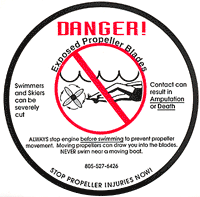DANGER !
On the type of injury:
 "The
available literature reveals an overall fatality rate of 15 to 17%, a similar rate of
major amputations. The injuries surpass by far those seen in other motor vehicle
accidents, and some authors compare the resulting wounds with those seen on the
battlefield. The wounds produced by this mechanism are chopping, cutting, penetrating
injuries produced by an extremely powerful fast moving, repetitive force that results in
multiple, severe blunt and/or sharp disruptions of both soft and bony tissues." (1) "The
available literature reveals an overall fatality rate of 15 to 17%, a similar rate of
major amputations. The injuries surpass by far those seen in other motor vehicle
accidents, and some authors compare the resulting wounds with those seen on the
battlefield. The wounds produced by this mechanism are chopping, cutting, penetrating
injuries produced by an extremely powerful fast moving, repetitive force that results in
multiple, severe blunt and/or sharp disruptions of both soft and bony tissues." (1)"Boat
propeller injuries, if not fatal, are usually severe and disfiguring resulting in
prolonged disability and permanent impairment requiring costly medical, surgical and
rehabilitative services." (2)
Dr. Charles T Blount testified in the Matthew Beech v Outboard Marine Corp that
propeller lacerations are more invasive to nerve damage and blood loss than blunt trauma
from being hit by the boat. (3)
On the propeller danger:
"The mechanism of production of propeller injuries is unique and very complex....
Rotating at a high speed and with a very powerful torque, when a propeller makes contact
with a body it will result in multiple impacts of great force by the moving and advancing
blades of the propeller. A typical three blade propeller running at 3,200 rpm can inflict
9,600 impacts in 1 minute or 160 impacts in 1 second. ... A 13 inch blade can travel from
head to toe in an average person in less than one tenth of a second." (1)
Contamination:
"When propeller injuries occur, the resulting complex wounds are immersed in water
that is contaminated to greater or lesser degrees. This results in gross contamination of
the severely traumatized tissues with unusual water bacteria." (3)
Healthcare providers:
"As a healthcare organization, our hospital - and its Emergency Department, in
particular - experiences first hand the devastating effects of numerous propeller-related
injuries each year. It is not unusual for us to receive several of these types of injuries
over a single holiday weekend. Moreover, the severity of these injuries tends to
be very
high, spanning the continuum from death, dismemberment/amputation, to complex orthopedic
injuries and severe lacerations involving substantial blood loss, shock and requiring
extensive surgical repair." (4)
"The societal and personal "costs" of these acute traumatic injuries is
significantly underestimated, in my opinion... These types of physically and economically
devastating injuries are, at least in significant part, preventable...." (4)
Public safety advocates:
"Public health practice in injury control has demonstrated that the most effective
means of preventing product-related injuries is to modify the product rather than
attempting to alter the behavior of millions of consumers." (5)
"Both as a student of public health injury and a practicing lawyer, I have seen
the consequences of contact between a person in the water and an unguarded motorboat
propeller. Typical victims suffer multiple, deep open wounds inflicted by the spinning
blades ... Propeller guards can greatly reduce the incidence of injury and death, by
interposing a barrier between the potential victim and the spinning blades of the
propeller. Propeller guards have been available for over fifty years, yet neither of the
two primary African manufacturers of motorboat engines include them on their
products."
"Legislation and regulation are the most direct, efficient and effective means of
establishing safety standards for unsafe consumer products. /Where industry interests and
consumer interests clash/ product liability litigation, though a blunt tool of last
resort, has been an important force for consumer protection in this century. Such suits
can directly lead to design changes, or can weaken industry resistance to design
regulation."
"I urge you /Coast Guard and NBSAC/ to accept the responsibility that comes with
your charge, and to require the industry which profits from the sale of dangerous
propellers to make their products safe by installing propeller guards." (6)
(1) "Motorboat Propeller Injuries," copyright l998 Lippincott-Raven
Publishers. Article by Miguel Mendez-Fernandez MD, FACS, FICS.
(2) "Motorboat Propeller Injuries," The Journal of the Florida Medical
Association, June 1987, Vol 74, No. 6 by Charles T Price, MD and Charles W. Moorfield,
M.D.
(3) Deposition August 29, 1989 of Dr. Charles T. Price. Including exhibits by Drs.
Hummel and Gainor, "Waterskiiing Related Injuries"; Dr. Mann "Propeller
Injuries; "Power Boat Injuries to Swimmers" Australian Medical Journal; and,
Sleight "Speedboat Propeller Injuries"
(4) Former Administrator, Dennis Zielinski, VP C.E.O. Havasu Samaritan Hospital, letter
of July 10, 1995
(5) "Motorboat Propeller Injuries" John Hopkins University Injury Prevention
Center and the Institute for Injury Reduction, Jon S. Vernick and Assoc.
(6) Testimony to NBSAC, April 29, 1996, San Francisco, Ca. by Eric Gorovitz, J.D.,
M.P.H., Legal Director, Trauma Foundation. |